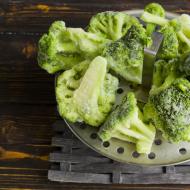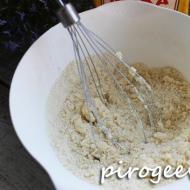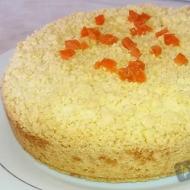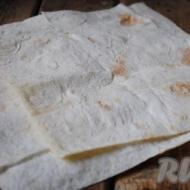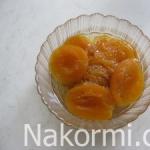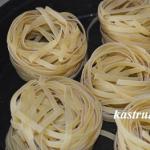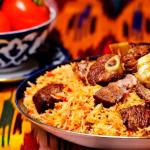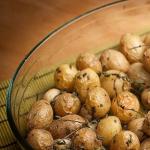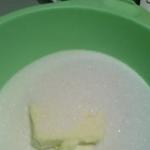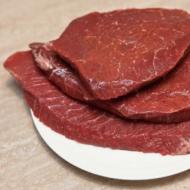
Olivier salad - what it really is. Who invented the Olivier Olivier salad - history of origin
The New Year is just around the corner, and for the “millionth” time, a salad bowl with Olivier will be on the holiday tables of residents of the entire post-Soviet space. This tradition has been observed for many decades by everyone whose roots go back to the USSR.
But few people thought about why this particular salad became a New Year’s “brand”, and where it even came from in the Soviet Union. It's time to find out the history of the dish, so popular that its name has become a household name.
French “guest worker” in Russia
Nowadays, it would never even occur to anyone that once upon a time people went not from Russia to Europe to work, but vice versa. But in the 19th century the picture was completely different.
Thus, a certain cook of French origin named Lucien Olivier left his homeland and went to “conquer the stomachs” of the citizens of the Russian Empire. He was inspired to do this by the crazy popularity of French cuisine among Russians at that time. And so Monsieur Olivier found an investor in Moscow - the wealthy merchant Yakov Pegov, and opened a restaurant called “Hermitage” in the 60s of the 19th century.
The popularity of the establishment grew quickly, so that after some time the Hermitage was followed by another restaurant on Trubnaya Square. But the attendance of the first one was higher, since Olivier himself was its chef. And it was in this restaurant that for the first time a salad appeared on the tables of high society visitors, which has not lost popularity for the third century in a row.

This is interesting: in addition to the famous dish, Lucien Olivier is the “father” of the most famous mayonnaise “Provencal”, thanks to which, by the way, the Olivier salad was so delicious. It was prepared by a Frenchman from egg yolks, mustard and olive oil with the addition of spices, the secret of which he did not reveal.
Hazel grouse, crayfish tails and mystery sauce
So, Lucien Olivier’s business flourished, the Hermitage was visited entirely by representatives of the Russian elite, and the talented chef had to keep his mark: periodically surprise visitors with something unusual and interesting. Olivier improvised, invented new recipes, and once served an unusual salad in his restaurant. At that moment, the chef had no idea that some 10 years after his death, this snack would already be called by his name in print media.
It's nice to realize that this dish was invented specifically for Russian lovers of delicious food. But none of us can say that we have eaten a real Olivier salad. After all, the original recipe from the modern one contained only such ingredients as potatoes, cucumbers, Provencal mayonnaise and boiled eggs. Well, and poultry meat. True, it was not a chicken at all, but hazel grouse or partridge.
The French delicacy also included crayfish necks, veal tongue, lettuce, pressed caviar, lanspique, or lanspig (gelled broth in which hazel grouse were boiled), and soy-kabul. The cook laid out all this in small piles on a large plate and poured over it with his signature Provençal. And a little later, when I observed how restaurant visitors eat the appetizer, I began to knead it before serving.

Almost none of the ingredients raise any questions. Yes, all of them do not fit in with the Olivier salad in our minds, but the products are familiar. But what is Kabul soybean? To answer this question, you need to turn to the moment the Olivier recipe appeared in print.
On the pages of culinary publications
Lucien Olivier came up with his signature salad in the late 60s of the 19th century, but the recipe was first published only in 1894 in the magazine “Our Food”, and not among other recipes, but in the “Questions and Answers” section, since many people were interested in “how is the Olivier appetizer prepared?”
Editor Ignatiev gave a detailed answer to this question. In addition to all of the above, he advised putting capers and olives in Olivier, seasoning it with cold Provencal sauce and adding Kabul soybeans. In winter, replace fresh cucumbers with pickled gherkins. This was in the sixth issue of the magazine for 1894.
Already in the tenth issue, the author of the column again returned to the topic of everyone’s favorite French salad. M.A. Ignatiev added a couple more tips to the publication. To ensure that the winter version of “Olivier” does not lose its original taste, he recommended putting borage plant instead of fresh cucumbers - the so-called “cucumber grass”, which tastes exactly like this vegetable. And you can grow borage in winter in a pot on the windowsill.
But restless readers did not lag behind. They still couldn’t get a salad that tasted exactly like the French chef’s delicacy. And the answer to the last question, published in No. 24 of the magazine “Our Food” of the same year, made them lose all hope for this.
This question concerned the mysterious “Kabul” sauce, or soy-Kabul. And Ignatiev replied that all versions of this sauce produced in Russia are only unsuccessful attempts to repeat the taste of the original dressing, which is manufactured by the Crosse & Blackwell company in London. And “the method of preparing real “kabul” is a company secret” - we quote Ignatiev’s answer verbatim.
So, unfortunately, the end is in the water. Because a request regarding Kabul sauce sent to The J.M. The Smucker Company, which still owns the thriving Crosse & Blackwell brand, remained unanswered.

It is only known that Kabul sauce is a thick, spicy gravy, which is prepared on the basis of flour sautéed in butter with the addition of meat broth and spices.
So we will never be able to try exactly the same salad that Lucien Olivier prepared.
This is interesting: For the coming year 2012, residents of Orenburg decided to prepare the largest Olivier salad in the history of its existence. The weight of the dish was 1841 kg. There were about 5,000 eggs alone!
Hard fate in an era of scarcity
As time passed, the country was subjected to severe trials - the Russians survived the revolution, the Civil and Great Patriotic Wars and a terrible hunger strike. Most of the USSR population could not even dream of such a luxury as the Olivier salad with hazel grouse, crayfish necks and veal tongue.
But everyone loved the salad so much that they didn’t want to give it up. They just simplified it and replaced the meat ingredients with boiled sausage. Plus we added boiled carrots and green peas due to the availability of these products. But the salad was still dressed with Provencal mayonnaise.
In the Soviet era, “Olivier” received a second name – “Winter”, because it contained ingredients that were freely available even in frosty weather.
Despite the simplicity and availability of most of the ingredients, “Olivier” was prepared only on holidays, because not every Soviet family could afford sausage more often than on special days. And since all religious dates were canceled in the USSR, the New Year became the brightest holiday. So “Olivier” became a New Year’s tradition.
The real Olivier salad recipe, invented by French chef Lucien Olivier
Cooking time: 1 hour 20 minutes
Number of servings: 50
Energy and nutritional value of the product
- proteins – 13.9 g;
- fats – 14.3 g;
- carbohydrates – 2 g;
- calorie content – 192.2 kcal.
Ingredients
- boiled hazel grouse meat – 600 g;
- boiled veal tongue – 1.5 kg;
- pressed black caviar – 100 g;
- fresh salad leaves – 200 g;
- boiled lobster – 1.1 kg;
- pickles – 200 g;
- canned soybeans – 200 g;
- soy sauce - to taste;
- fresh cucumbers – 200 g;
- capers – 100 g;
- boiled chicken eggs – 5 pcs.;
- Provencal mayonnaise – 500 g.
Step-by-step description of the cooking process
- Cut the hazel grouse meat boiled in beef broth with the addition of seasonings, Madeira, champignons and olives and cooled into small, uniform pieces.
- Peel the boiled veal tongue and chop it together with pressed black caviar, ready lobster meat removed from the shell, chicken eggs, washed and dried fresh cucumbers and pickles into small cubes.
- Rinse the salad leaves thoroughly under a low pressure running stream, blot each leaf with a paper towel and tear it into small pieces with your hands - this will taste better than the cut product.
- Carefully remove the capers from the jar and chop them as finely as possible.
- Strain the amount of canned soybeans required according to the recipe from the liquid, grind into a homogeneous mass in a mortar and season with a small amount of soy sauce to taste, but most importantly do not overdo it.
- Combine all the prepared ingredients listed above in a common bowl, season them with Provencal mayonnaise and serve in portioned bowls.

This is interesting: the popular salad in Russia is even an unofficial way to determine purchasing power parity. In 2009, the Trud newspaper published the “Olivier Index” - a figure by which one could see the level of inflation in consumer prices for food. And it reflects this better than Rosstat data. This indicator has become an analogue of the “Big Mac Index” in America.
This exquisite dish, presented to our great-great-ancestors more than a century and a half ago by Lucien Olivier, has traveled a long winding path and has come to us completely new, but no less tasty. And we live in a time when in the field of gastronomy you can get any product without having to come up with a replacement for it.
So if you really want to feel the taste of the classic “Olivier”, which was enjoyed by the cream of Russian society in the 19th century in the Hermitage restaurant, go for it! With a huge number of videos of cooking master classes from leading chefs, this will not be difficult at all.
Each of us has tried Olivier salad at least once in our lives. It is considered a traditional dish of Russian cuisine. Now I will tell you the history of the Olivier salad and we will see whether this is really a Russian dish or whether Russians just really liked it.
History of Olivier salad
The word "Olivier" is French and this makes us understand that the salad bears the name of the Frenchman who invented it. And now everything is in order. In the 19th century, there was a fashion for French culture in Russia, Lucien Olivier took advantage of the moment and opened a luxurious restaurant in the center of Moscow called the Hermitage.
Mayonnaise Olivier
Initially, the Olivier family became famous thanks to the unique taste of mayonnaise using a secret recipe with the addition of spices, but soon the canons of beauty changed and the demand for mayonnaise fell sharply. To save his restaurant, Lucien Olivier began to come up with new dishes, one of which was to the taste of all visitors. It was game mayonnaise, it caused a stir among visitors and many guests came to the restaurant just for this dish. What does the Olivier salad have to do with it, you ask? The thing is that this delicacy was decorated on the sides with potatoes, eggs and gherkins. The restaurant owner began to increasingly notice that visitors were mixing game mayonnaise with other ingredients and created this salad. We can say that the visitors themselves inspired Lucien Olivier to create a brilliant dish. It is worth noting that the modern Olivier recipe differs from what the chef came up with in his time.
Composition of Olivier salad according to the traditional recipe:
- Black caviar
- Grouse
- Beef tongue
- Soybean Kabul
- Capers
- Cucumbers
- Lettuce leaves
- Refueling
Now you know the history of Olivier salad, and you can find out about the benefits of mold
30.11.2019 at 22:00 685
A New Year's feast is unthinkable without the famous Olivier salad. The legendary dish was invented more than a century and a half ago, writes RIA Novosti. And although its author was a Frenchman, all over the world this hearty and very tasty salad is called nothing less than Russian. The famous metropolitan chef Anatoly Seleznev spoke about how the Olivier recipe, considered one of the symbols of the New Year, has transformed over time..
It is well known that the salad was invented by the French chef Lucien Olivier. But because at that time he lived and worked in Moscow, where he owned one of the most popular restaurants of French cuisine at that time, “Hermitage”, later in many countries of the world this dish became known as Russian salad.
It is believed that Olivier never revealed the secret of his salad. More precisely, the recipe for the sauce that was used to dress the salad remained unsolved. Allegedly, the cook added some seasonings known only to him, which made the taste of the dish truly unforgettable.
 Lucien Olivier
Lucien Olivier A cook of French or Belgian origin who ran the Hermitage restaurant in Moscow in the early 1860s
However, we know the ingredients of the dish itself. In the classic version, hazel grouse fillet, boiled veal tongue, crayfish necks, potatoes, capers, boiled eggs, fresh or pickled cucumbers, lettuce and soy-kabul, that is, soybean paste, were added to the salad. The dish was seasoned with a sauce made from olive oil, egg yolks, vinegar and mustard. Now it is known as mayonnaise. Judging by the reviews of guests of the Hermitage restaurant, the salad, which very quickly became a favorite dish of visitors, was decorated with black caviar.
During the Soviet years, “Olivier” not only did not lose, but, on the contrary, strengthened its position as a popular dish among the population. True, over time, its components were replaced with more accessible and cheaper products. For example, hazel grouse meat gave way to Doctor's sausage, crayfish tails to boiled carrots, and capers to green peas. The housewives didn’t bother with the sauce either: most preferred to season the salad with store-bought Provencal mayonnaise.
 gastronom.ru
gastronom.ru Surprisingly, the salad did not become any less tasty. It just turned out different. Of course, in this form it only vaguely resembled the dish invented by the French. But its variability continued to grow. Housewives mostly experimented with meat added to salads: it could be boiled chicken, beef, or pork. Some tried to diversify the taste of the famous dish with the help of finely chopped apples.
Soviet recipe for Olivier salad:
-2-3 boiled potatoes
-1 boiled carrot
-300 grams of Doctor's sausage
-2-3 hard-boiled chicken eggs
-0.5 cans of canned green peas
-2-3 salted or pickled cucumbers
-Green onions
-Dill
-2-3 tablespoons of mayonnaise
Cut all ingredients into cubes, mix, add salt to taste and season with mayonnaise. Sprinkle chopped herbs on top.
Depending on the ingredients used, the number of salad names also grew. In many menus it began to be called “Stolichny”, “Meat”, “Winter”. Abroad, the name “Russian” was firmly assigned to him.
Of course, now the most sophisticated audience is fed up with the traditional Olivier, and chefs are trying to diversify its taste. Olivier with lightly salted salmon and flying fish caviar is popular.
 pinterest.com
pinterest.com Recipe for “Olivier” with smoked eel from Anatoly Seleznev:
Peel and boil two medium potatoes and one carrot. Cool and chop them into cubes. Add 200-300 grams of smoked eel, cut into thin slices, to the chopped vegetables. Chop one small fresh cucumber into strips. Blanch frozen green peas (3-4 tablespoons) for 2-3 minutes in salted water, drain in a colander and add to the rest of the ingredients. Add chopped onion or chives there and mix everything carefully. Season the salad with mayonnaise. Possibly Japanese. Then boil 3-4 quail eggs, peel, cut in half and place on top. Garnish the finished salad with pike caviar (2-3 teaspoons) and herbs - rosemary, mint, basil, thyme.
Russians are idealists and great inventors. Russian Sherlock Holmes is the most soulful of all existing ones, films about cowboys are kind and thoroughly imbued with the Russian spirit, and what can we say about the famous “Three Musketeers”... Well, can French pedants compare with the charming Boyarsky with a radiant smile. The same thing happens not only in cinema, but also in Russian cooking. Many dishes from foreign cuisines are processed to suit our needs, acquiring in our conditions a new, and sometimes completely different, taste. This happened with the Olivier salad. The history of Olivier salad is known to few. The famous Olivier salad was invented by a French chef in Russia in the second half of the 19th century, and the name of the famous chef misleads many. Nevertheless, a fact is a fact. Lucien Olivier is the founder of the famous Hermitage restaurant, as well as the author of a magnificent salad that is still alive.
The elite Hermitage restaurant was built by Lucien Olivier after many years of living in Moscow, when he realized what was missing in the Russian capital. The French chic was missing. Joining forces with the wealthy merchant Yakov Pegov, Olivier buys a plot in the center of Moscow and intends to build a first-class restaurant according to the best French standards. By the mid-60s of the 19th century, on the site of a booth selling snuff, a luxurious building with white columns, crystal chandeliers, isolated offices and luxurious interiors arose. This was a new thing for Moscow at that time, and the nascent bourgeoisie poured into the restaurant. At first, Olivier’s establishment was called the Tavern in the Russian way, and the waiters were also dressed in the “tavern style.” The following facts can speak about the importance and popularity of the restaurant: in 1879, a gala dinner was held in the Hermitage in honor of I.S. Turgenev, in 1880 - in honor of F.M. Dostoevsky, in 1899 - the famous celebration of the centenary of Pushkin’s birthday, which was attended by all the eminent writers and poets of that time. In the Hermitage, university professors celebrated anniversaries and students celebrated Tatiana's Day, the intelligentsia gathered and rich merchants feasted. In general, Olivier's restaurant, as well as its excellent cuisine, attracted the best people of that time.
Lucien Olivier, the youngest of the three Olivier brothers, with whom the history of the Olivier salad began, was very young and went to Moscow to work. Like many Frenchmen, he hoped to use his culinary skills in a country that has always respected French cuisine. While his brothers were cooking for French gourmets, Lucien was opening his restaurant, the Hermitage. At first, the business brought in significant income, and the young Frenchman prepared dishes familiar from childhood. This success was greatly facilitated by the “family” recipe, an improvement of mayonnaise sauce or mayonnaise. At the beginning of the 19th century, the Olivier family began to add mustard when making the sauce, as well as several secret spices, which made the taste of the familiar sauce slightly spicy. The popularity of the Olivier family's mayonnaise was so strong that it allowed the older brothers to keep their business in France, and Lucien to open a Moscow “branch” on Trubnaya Square. The building in which the restaurant was located has still been preserved; it is house number 14 on Petrovsky Boulevard, corner of Neglinnaya. So someday a memorial plaque or a whole monument to “Olivier Salad” may appear on it.
 But everything is transitory in this world, and gradually the sauce alone became not enough for the success of the establishment. Its taste quickly became boring, and the changing fashion swung towards skinny, pale young ladies, whose beauty, naturally, was hampered by the appetizing and high-calorie Olivier sauces. There was an urgent need to come up with something. And then Lucien Olivier came up with a new salad, a true work of art. His taste was so exquisite that it instantly brought the Frenchman the fame of a great chef, and the popularity of his restaurant, which was beginning to fade, flared up with renewed vigor. Visitors named the new salad “Olivier Salad,” which was quite in the tradition of Russian names. Since then, the name Olivier has become a household name, and they have tried to repeat the salad countless times, eventually simplifying the recipe so much that its modern version is the exact opposite of the original. Many chefs tried to repeat Olivier’s recipe, but, not knowing all the components, they inevitably failed - the taste of the real “Olivier Salad” could only be appreciated in the Hermitage restaurant.
But everything is transitory in this world, and gradually the sauce alone became not enough for the success of the establishment. Its taste quickly became boring, and the changing fashion swung towards skinny, pale young ladies, whose beauty, naturally, was hampered by the appetizing and high-calorie Olivier sauces. There was an urgent need to come up with something. And then Lucien Olivier came up with a new salad, a true work of art. His taste was so exquisite that it instantly brought the Frenchman the fame of a great chef, and the popularity of his restaurant, which was beginning to fade, flared up with renewed vigor. Visitors named the new salad “Olivier Salad,” which was quite in the tradition of Russian names. Since then, the name Olivier has become a household name, and they have tried to repeat the salad countless times, eventually simplifying the recipe so much that its modern version is the exact opposite of the original. Many chefs tried to repeat Olivier’s recipe, but, not knowing all the components, they inevitably failed - the taste of the real “Olivier Salad” could only be appreciated in the Hermitage restaurant.
The taste of the famous dish was achieved to a large extent due to Monsieur Olivier’s own mayonnaise recipe. They said that the Frenchman jealously kept the cooking recipe and carried out the operation of preparing it in a special room behind a closed door. The journey of the sauce was not easy. Initially, Olivier made a sauce called “Game Mayonnaise.” It consisted of boiled fillets of hazel grouse and partridge, layered with layers of jelly from the broth. Along the edges of the dish lay boiled crayfish necks and small pieces of tongue. All this was flavored with a small amount of homemade Provencal sauce. In the center of the structure was a mound of potatoes with gherkins and slices of boiled eggs as decoration. At the same time, according to the author’s plan, the central potato part was intended rather for beauty. One day, Lucien Olivier noticed that some Russians who ordered this dish immediately broke the whole plan, stirring the entire structure with a spoon, and devoured this tasty mass with great appetite. The next day, an enterprising Frenchman mixed all the ingredients and poured a thick sauce on it. This is how the famous salad was born, reborn from the refined but inconvenient “game mayonnaise” into the no less refined, but closer to the Russian soul, “Olivier salad.”
Here is the recipe for the classic “Olivier salad”, prepared in better times in the Hermitage restaurant (restored in 1904 according to the descriptions of one regular of the restaurant):
Fillet of two boiled hazel grouse,
One boiled veal tongue,
About 100 grams of pressed black caviar,
200 grams of fresh lettuce leaves,
25 boiled crayfish or one large lobster,
200-250 grams of small cucumbers,
Half a jar of Kabul soya (soybean paste),
2 finely chopped fresh cucumbers,
100 grams of capers,
5 finely chopped, hard-boiled eggs,
Dressing with Provencal sauce: 400 grams of olive oil, beaten with two fresh egg yolks, with the addition of French vinegar and mustard.
One of the secrets of the classic taste of Olivier salad was the addition of certain spices by the Frenchman. The composition of these seasonings, unfortunately, is unknown, so the true taste of the salad can only be imagined based on the descriptions of contemporaries.
The preparation itself was no less exciting:
Fry the hazel grouse in a 1-2 centimeter layer of oil over high heat for 5-10 minutes. Then put them in boiling water or broth (beef or chicken), add 150 ml Madeira per 850 ml broth, 10-20 pitted olives, 10-20 small mushrooms and cook for 20-30 minutes over low heat, covered. When the meat begins to slightly separate from the bones, add salt, let cook for a couple more minutes and turn off the flame. Place the pan with hazel grouse, without pouring out the broth, into a large container with cold water and let cool. The purpose of this is to allow the hazel grouse meat to cool gradually. The fact is that when separated while hot, the meat begins to dry out and loses its tenderness. However, it is necessary not to overdo it and separate the warm meat - do not let the hazel grouse freeze, otherwise it will completely stop being removed from the bones. Wrap the removed meat in foil and place in a cool place. Do not pour out the broth after cooking the mushrooms - it will make a great soup! (if you don’t find hazel grouse and decide to replace them with chicken, remember - the chicken must be cut into 2-3 parts and cooked a little longer - 30-40 minutes).
The tongue should be free of fat, lymph nodes, sublingual muscle tissue and mucus. Perhaps half the tongue will be enough. Rinse the tongue thoroughly in cold water, put it in cold water, bring to a boil and cook over low heat with the lid tightly closed for 2-4 hours (the time depends on the age of the owner of the tongue - for a young calf 2 hours will be enough). Half an hour before the tongue is ready, add chopped carrots, parsley root, onions and a piece of bay leaf to the same saucepan. Add salt 5-10 minutes before the end of cooking. As soon as the tongue is cooked, immediately place it in a container of cold water for 20-30 seconds, then place it on a plate and remove the skin from it (if the tongue still burns your fingers, dip it in water again). After cleaning the tongue, put it back into the broth and quickly bring it to a boil, then turn off the flame and set the pan to cool in a large container filled with ice water. Also wrap the cooled tongue in foil and place it in a cool place.
Cut pressed caviar into small cubes.
Wash the lettuce leaves thoroughly, dry and cut immediately before cooking.
Dip live crayfish, washed in cold water, into the boiling solution, head down. To prepare a solution for boiling crayfish, take: 25 grams of parsley, onions and carrots, 10 grams of tarragon, 30-40 grams of dill, 1 bay leaf, a few peas of allspice and 50 grams of salt. After placing the crayfish in boiling water, let the water boil again and cook for another 10 minutes. After turning off the heat, do not remove it immediately, but let the crayfish brew, then cool the pan with the finished crayfish using the method described above.
Finely chop the pickles right before mixing.
Grind the soybeans before adding to the salad.
Peel fresh cucumbers and chop finely (not necessarily evenly - you can also “crush”). Also chop the capers finely, after drying them.
Eggs should be large and fresh. Do not overcook them under any circumstances. Pay close attention to this part. The eggs should feel fresh and the whites should be tender, not rubbery. Cook for 7-8 minutes, but not 15.
Chop all the ingredients and mix (try to do this carefully, using upward movements). Add your own homemade mayonnaise and serve immediately. It is important to take into account the amount of alcohol guests drink. The more, the hotter the sauce should be. If the guests are sober, then it would be more logical to season with classic mayonnaise in order to appreciate the delicate taste of all the ingredients.
This was the recipe at the time it was reproduced by one of the restaurant’s regular customers. Perhaps something was not taken into account, but the main components that are difficult to hide from the sophisticated public are present in the recipe. The secret of the spices that made the taste of the dish signature and unique, unfortunately, has been lost. After the death of Lucien Olivier in 1883, the Hermitage restaurant went to the “Olivier Partnership”; for a long time the restaurant passed from hand to hand, and the famous recipe went to the rich houses of the capital, or rather to the kitchens of these houses. The personal chefs of many of the capital's richest people tried to recreate the French master's recipe and offered this famous salad at dinner parties. This situation could have lasted forever if not for the First World War and then the revolution of 1917. The sudden disappearance of many products hit Olivier salad hard. At that time there was no time for delights - for many years the country plunged into the darkness of timelessness, and on the food side - into severe hunger and a rationing system for food distribution. But already in 1924, the era of NEP began and products that seemed irretrievably gone again appeared in the country. However, much was no longer possible to return. Branded “bourgeois” hazel grouse or crayfish necks became unavailable, and simply irrelevant among the city dwellers of that time. NEP times gave us several salad options. One of these restaurants, and it must be said that it was central at that time, since senior party workers dined there, was the Moscow restaurant. It was headed by Ivan Mikhailovich Ivanov. He preserved, although in a modified form, the recipe for the famous dish, close to the original. And the realities of time have made their own changes to the recipe.
 So, - Olivier Salad recipe according to a Moscow restaurant in the mid-20s of the 20th century:
So, - Olivier Salad recipe according to a Moscow restaurant in the mid-20s of the 20th century:
Ingredients:
6 potatoes,
2 onions,
3 medium sized carrots,
2 pickled cucumbers,
1 apple,
200 grams of boiled poultry meat,
1 glass of green peas,
3 boiled eggs,
half a glass of olive mayonnaise,
salt, pepper to taste.
Preparation:
Take medium-sized, fresh vegetables. Cut all ingredients finely and very evenly into equal pieces. Boil the potatoes and carrots, peel them, chop everything, mix and season with mayonnaise, top with parsley and apple slices.
In the early 30s, the chef of the Moscow restaurant, Ivan Mikhailovich Ivanov, adjusted Lucien Olivier’s recipe according to the times, calling the salad “Stolichny”. This name is not reflected in the book “On Tasty and Healthy Food” of 1939, but it does contain “Game Salad”, the recipe for which is strikingly similar to Olivier’s salad. The 1955 cookbook “Capital Salad” has an adapted, but nevertheless close to the original composition.
Capital salad.
Ingredients:
60 g poultry or game,
60 g potatoes,
40 g fresh, salted or pickled cucumbers,
10 g green salad,
10 g of crayfish necks,
45 g eggs,
15 g “Yuzhny” sauce,
70 g mayonnaise,
10 g pickles,
10 olives.
Preparation:
Cut boiled or fried poultry or game, boiled peeled potatoes, fresh, salted or pickled cucumbers, hard-boiled eggs into thin slices (2-2.5 cm). Finely chop the green salad leaves. Mix everything, season with mayonnaise, add “Yuzhny” sauce. Place the salad in a heap in a salad bowl and decorate with mugs or slices of hard-boiled eggs, pieces of pickles, lettuce leaves, and mugs of fresh cucumbers. On the salad you can put beautifully cut slices of game fillet, crayfish tails or pieces of canned crab and olives.
The main principle - chop everything and season with mayonnaise - became widespread throughout the Soviet and post-Soviet space, giving rise to many variations on the theme of the famous salad, and the modern version of Olivier salad is called “Russian salad” or “salade a la Russe” all over the world. Hazel grouse were first replaced with partridges, then chicken, and then just sausage. There were also recipes with beef, but this is too tough a component, and beef did not take root. Crayfish necks, unfortunately, have sunk into oblivion, and in the 20th century they were no longer added to salads; boiled carrots were added instead. Capers were replaced with more accessible green peas, and onions appeared in the salad, which immediately acquired a pungent taste. Lettuce leaves were replaced with parsley. Soy, veal tongue, as well as pressed black caviar (and truffles, according to one version), also disappeared from the recipe. Mayonnaise was replaced from homemade mayonnaise to factory made. Be that as it may, the Olivier salad continued to live even in these difficult conditions, being a symbol of chic and delicacy for a large part of the impoverished country. In the post-war period, in the second half of the 50s, when the country was experiencing powerful growth and the standard of living rose again, the old salad reappeared on the holiday table. Many products returned to sale, but even banal peas or Provencal mayonnaise were in terrible short supply, and these products were always set aside to create the “holiday” Olivier salad. Simplifying, Olivier's salad recipe acquired the main thing - from a rather high-calorie dish, with tasty, but still heavy and expensive ingredients, the salad became a vegetable salad, the meat portion of which was incomparably small.
As in the 19th century, modern Olivier salad is made from those products that are most available at the moment. If then caviar, crayfish necks, hazel grouse and capers were available, now it is boiled sausage, green peas, carrots and onions. And you can buy mayonnaise in the store. Losing expensive ingredients, the salad inevitably gained popularity among wide sections of the population of one sixth of the planet, and now boasts not just a name, but the name of a whole class of salads that began to appear in late Soviet times. After all, salad with canned fish and crab sticks, as well as numerous other Soviet salads, appeared thanks to the ingenuity and partly poverty of the counters, forcing the imagination of housewives and cooks to work. The symbolic significance of Olivier salad for Russian cuisine cannot be overestimated. This is always the main dish on the table, in the best salad bowl; no other salad deserves such a constant presence at a festive feast. The tradition of putting food on plates is indicative. Olivier is always placed either first or after the potatoes. This respectful attitude towards a simple salad could not hide from the unobtrusive gaze of foreign guests, who, of course, were also treated to Olivier salad. Throughout the rest of the world, our salad is known as “Russian salad,” but it is most correct to call the modern version of the dish “Soviet Olivier.” Like “Soviet champagne,” it has its own destiny, its own unforgettable taste and is considered the same powerful and indestructible symbol of the holiday.
It is with “Olivier” that any celebration is associated, for example, the New Year’s table. This salad is one of the symbols of the New Year celebration. Almost every table always has a bowl of salad. But has anyone thought about who invented the holiday appetizer and the history of the origin of Olivier salad?
The history of the origin of the Olivier salad
Olivier got its name from the name of the man who came up with this recipe. His name is Lucien Olivier. He worked as a chef at a French restaurant called Hermitage in Moscow. This was in the eighteenth century. The chef's ancestors come from France. The Olivier dynasty lived in Provence. The family was a professional cook and gained fame in their homeland for creating an unusual sauce, which they patriotically named “Provencal”, in honor of the province of France where the family was from. Now this sauce is called mayonnaise. The youngest of the Olivier brothers, whose name was Lucien, went to conquer Moscow, where he came up with his unique salad “Olivier”. At that time, cooking in Russia was lame; restaurants served such snacks as pickles and sauerkraut, cranberries or mushrooms. Salad was considered a pickle, seasoned with sour cream. Then Lucien decided to conquer the culinary community of Russia, to do something unique, new and inimitable. The key concept was the lightness of the salad. The restaurant had a council of chefs on the theme of the new product, each offering their own versions. Olivier spent several days conjuring his salad, conducting samples and tastings. As a result, a light salad was developed that glorified its creator, Lucien Olivier.
It is believed that the cook did not reveal the original recipe for the salad. But we have reached two publications mentioning a recipe for a salad similar to Olivier.
Recipe for the original Olivier salad
First recipe: 
- Cut half the carcass of fried hazel grouse.
- Boil three potatoes and cut into cubes.
- Cut one fresh cucumber into slices.
- Three to five olives.
- Capers - one teaspoon (small cabbage).
- Chop the ingredients, season, mix.
- Provencal - 20 grams for salad dressing.
- Three to four lettuce leaves for decoration.
- Three necks of crayfish for decoration.
- Lanspik - 100 grams (transparent broth used to prepare aspic). Designed for decoration.
Second option, from another source of that time:
- Two hazel grouse
- Beef tongue,
- 100 grams of pressed caviar,
- 50 grams of lettuce leaves,
- 25 boiled crayfish,
- 100 grams of pickles,
- 100 grams of soy-kabul,
- two cucumbers,
- 100 grams of capers,
- 5 boiled eggs,
- mayonnaise.
The cooking method is the same, cut the boiled products, season with sauce.
 Until today, the original recipe has undergone huge changes, because Olivier was usually prepared only from hazel grouse. Nowadays this salad usually consists of the following products:
Until today, the original recipe has undergone huge changes, because Olivier was usually prepared only from hazel grouse. Nowadays this salad usually consists of the following products:
- Boiled potatoes - about seven pieces,
- Fresh cucumber - five pieces,
- Boiled sausage - half a kilogram,
- Boiled eggs - four pieces,
- Mayonnaise,
- Green peas - one jar,
- Dill.
Cooking method:
- Cut everything into cubes.
- Season with mayonnaise.
- Add dill.
- Mix.
For example, one of these recipes suggests shrimp instead of sausage, avocado instead of cucumbers.

